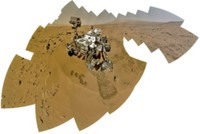Advertisement
Grab your lab coat. Let's get started
Welcome!
Welcome!
Create an account below to get 6 C&EN articles per month, receive newsletters and more - all free.
It seems this is your first time logging in online. Please enter the following information to continue.
As an ACS member you automatically get access to this site. All we need is few more details to create your reading experience.
Not you? Sign in with a different account.
Not you? Sign in with a different account.
ERROR 1
ERROR 1
ERROR 2
ERROR 2
ERROR 2
ERROR 2
ERROR 2
Password and Confirm password must match.
If you have an ACS member number, please enter it here so we can link this account to your membership. (optional)
ERROR 2
ACS values your privacy. By submitting your information, you are gaining access to C&EN and subscribing to our weekly newsletter. We use the information you provide to make your reading experience better, and we will never sell your data to third party members.
Physical Chemistry
Mars Is Drier Than Expected
New images show lava, landslides instead of watery residues
by Elizabeth K. Wilson
September 24, 2007
| A version of this story appeared in
Volume 85, Issue 39
PUTTING A DAMPER on some of the recent effusiveness about possible evidence for past and present water on Mars, new images of the red planet show that many features once attributed to gushing floods and rivers may instead be landslides or lava flows.
NASA's Mars Reconnaissance Orbiter (MRO) spacecraft, which sent back to Earth the striking new images, like the gullies shown here (right image), has a suite of instruments with much greater resolving power than those in previous craft. With its ability to pick out 1-meter-sized boulders and narrow crevasses, it was expected to answer a lot of questions about Mars's geologic history.
Just last year, NASA's Mars Global Surveyor spotted a new bright patch in a gully, which was believed to be evidence of a recent gush of water on Mars (C&EN Online, Latest News, Dec. 11, 2006).
But international teams of planetary scientists now report in a series of papers (Science 2007, 317, 1706, 1709, 1711, and 1715) that signs of water flow have been harder to find than expected in the new images. Some gullies do resemble those formed by water flow on Earth, but the new bright patches appear likely to be the result of dry landslides. MRO also reveals that a large field of channels once thought to be formed by water is covered by lava. Other regions of the planet are littered with boulders, rather than the snow or ancient ocean sediments once postulated.
But that doesn't mean that Mars is and always has been dry as a bone. Some geologic features, such as the fan-shaped swath of channels shown (left image) in an impact crater, appear to have been created by fluid flow.
MRO will continue mapping the planet for another year, after which it will serve as a communications relay for future Mars missions.






Join the conversation
Contact the reporter
Submit a Letter to the Editor for publication
Engage with us on Twitter